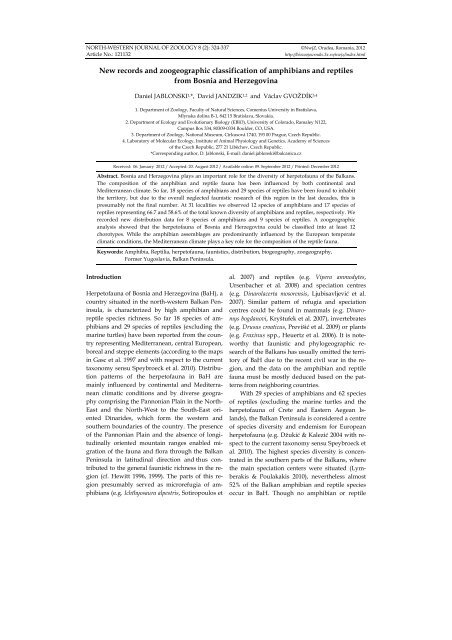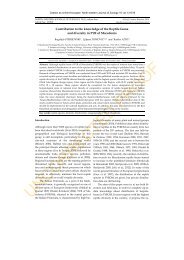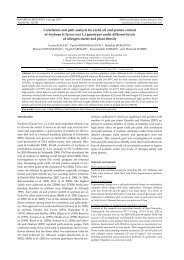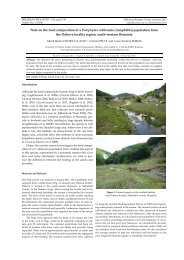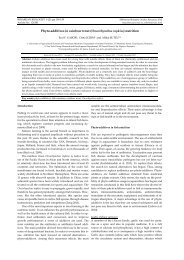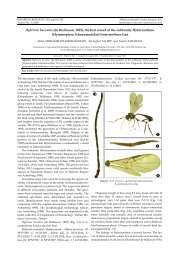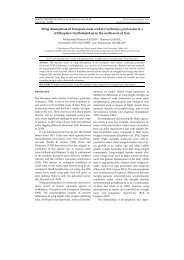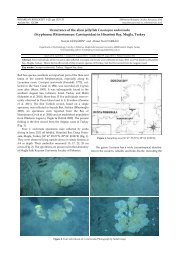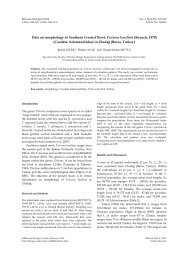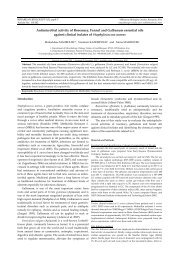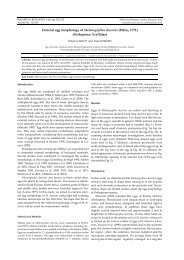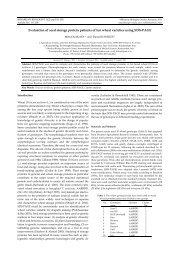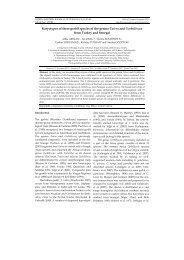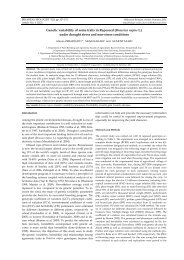New records and zoogeographic classification of amphibians and ...
New records and zoogeographic classification of amphibians and ...
New records and zoogeographic classification of amphibians and ...
Create successful ePaper yourself
Turn your PDF publications into a flip-book with our unique Google optimized e-Paper software.
NORTH-WESTERN JOURNAL OF ZOOLOGY 8 (2): 324-337 ©NwjZ, Oradea, Romania, 2012<br />
Article No.: 121132 http://biozoojournals.3x.ro/nwjz/index.html<br />
<strong>New</strong> <strong>records</strong> <strong>and</strong> <strong>zoogeographic</strong> <strong>classification</strong> <strong>of</strong> <strong>amphibians</strong> <strong>and</strong> reptiles<br />
from Bosnia <strong>and</strong> Herzegovina<br />
Daniel JABLONSKI 1,*, David JANDZIK 1,2 <strong>and</strong> Václav GVOŽDÍK 3,4<br />
1. Department <strong>of</strong> Zoology, Faculty <strong>of</strong> Natural Sciences, Comenius University in Bratislava,<br />
Mlynska dolina B-1, 842 15 Bratislava, Slovakia.<br />
2. Department <strong>of</strong> Ecology <strong>and</strong> Evolutionary Biology (EBIO), University <strong>of</strong> Colorado, Ramaley N122,<br />
Campus Box 334, 80309-0334 Boulder, CO, USA.<br />
3. Department <strong>of</strong> Zoology, National Museum, Cirkusová 1740, 193 00 Prague, Czech Republic.<br />
4. Laboratory <strong>of</strong> Molecular Ecology, Institute <strong>of</strong> Animal Physiology <strong>and</strong> Genetics, Academy <strong>of</strong> Sciences<br />
<strong>of</strong> the Czech Republic, 277 21 Liběchov, Czech Republic.<br />
*Corresponding author, D. Jablonski, E-mail: daniel.jablonski@balcanica.cz<br />
Received: 06. January 2012 / Accepted: 20. August 2012 / Available online: 09. September 2012 / Printed: December 2012<br />
Abstract. Bosnia <strong>and</strong> Herzegovina plays an important role for the diversity <strong>of</strong> herpet<strong>of</strong>auna <strong>of</strong> the Balkans.<br />
The composition <strong>of</strong> the amphibian <strong>and</strong> reptile fauna has been influenced by both continental <strong>and</strong><br />
Mediterranean climate. So far, 18 species <strong>of</strong> <strong>amphibians</strong> <strong>and</strong> 29 species <strong>of</strong> reptiles have been found to inhabit<br />
the territory, but due to the overall neglected faunistic research <strong>of</strong> this region in the last decades, this is<br />
presumably not the final number. At 31 localities we observed 12 species <strong>of</strong> <strong>amphibians</strong> <strong>and</strong> 17 species <strong>of</strong><br />
reptiles representing 66.7 <strong>and</strong> 58.6% <strong>of</strong> the total known diversity <strong>of</strong> <strong>amphibians</strong> <strong>and</strong> reptiles, respectively. We<br />
recorded new distribution data for 8 species <strong>of</strong> <strong>amphibians</strong> <strong>and</strong> 9 species <strong>of</strong> reptiles. A <strong>zoogeographic</strong><br />
analysis showed that the herpet<strong>of</strong>auna <strong>of</strong> Bosnia <strong>and</strong> Herzegovina could be classified into at least 12<br />
chorotypes. While the amphibian assemblages are predominantly influenced by the European temperate<br />
climatic conditions, the Mediterranean climate plays a key role for the composition <strong>of</strong> the reptile fauna.<br />
Keywords: Amphibia, Reptilia, herpet<strong>of</strong>auna, faunistics, distribution, biogeography, zoogeography,<br />
Former Yugoslavia, Balkan Peninsula.<br />
Introduction<br />
Herpet<strong>of</strong>auna <strong>of</strong> Bosnia <strong>and</strong> Herzegovina (BaH), a<br />
country situated in the north-western Balkan Peninsula,<br />
is characterized by high amphibian <strong>and</strong><br />
reptile species richness. So far 18 species <strong>of</strong> <strong>amphibians</strong><br />
<strong>and</strong> 29 species <strong>of</strong> reptiles (excluding the<br />
marine turtles) have been reported from the country<br />
representing Mediterranean, central European,<br />
boreal <strong>and</strong> steppe elements (according to the maps<br />
in Gasc et al. 1997 <strong>and</strong> with respect to the current<br />
taxonomy sensu Speybroeck et al. 2010). Distribution<br />
patterns <strong>of</strong> the herpet<strong>of</strong>auna in BaH are<br />
mainly influenced by continental <strong>and</strong> Mediterranean<br />
climatic conditions <strong>and</strong> by diverse geography<br />
comprising the Pannonian Plain in the North-<br />
East <strong>and</strong> the North-West to the South-East oriented<br />
Dinarides, which form the western <strong>and</strong><br />
southern boundaries <strong>of</strong> the country. The presence<br />
<strong>of</strong> the Pannonian Plain <strong>and</strong> the absence <strong>of</strong> longitudinally<br />
oriented mountain ranges enabled migration<br />
<strong>of</strong> the fauna <strong>and</strong> flora through the Balkan<br />
Peninsula in latitudinal direction <strong>and</strong> thus contributed<br />
to the general faunistic richness in the region<br />
(cf. Hewitt 1996, 1999). The parts <strong>of</strong> this region<br />
presumably served as microrefugia <strong>of</strong> <strong>amphibians</strong><br />
(e.g. Ichthyosaura alpestris, Sotiropoulos et<br />
al. 2007) <strong>and</strong> reptiles (e.g. Vipera ammodytes,<br />
Ursenbacher et al. 2008) <strong>and</strong> speciation centres<br />
(e.g. Dinarolacerta mosorensis, Ljubisavljević et al.<br />
2007). Similar pattern <strong>of</strong> refugia <strong>and</strong> speciation<br />
centres could be found in mammals (e.g. Dinaromys<br />
bogdanovi, Kryštufek et al. 2007), invertebrates<br />
(e.g. Drusus croaticus, Previšić et al. 2009) or plants<br />
(e.g. Fraxinus spp., Heuertz et al. 2006). It is noteworthy<br />
that faunistic <strong>and</strong> phylogeographic research<br />
<strong>of</strong> the Balkans has usually omitted the territory<br />
<strong>of</strong> BaH due to the recent civil war in the region,<br />
<strong>and</strong> the data on the amphibian <strong>and</strong> reptile<br />
fauna must be mostly deduced based on the patterns<br />
from neighboring countries.<br />
With 29 species <strong>of</strong> <strong>amphibians</strong> <strong>and</strong> 62 species<br />
<strong>of</strong> reptiles (excluding the marine turtles <strong>and</strong> the<br />
herpet<strong>of</strong>auna <strong>of</strong> Crete <strong>and</strong> Eastern Aegean Isl<strong>and</strong>s),<br />
the Balkan Peninsula is considered a centre<br />
<strong>of</strong> species diversity <strong>and</strong> endemism for European<br />
herpet<strong>of</strong>auna (e.g. Džukić & Kalezić 2004 with respect<br />
to the current taxonomy sensu Speybroeck et<br />
al. 2010). The highest species diversity is concentrated<br />
in the southern parts <strong>of</strong> the Balkans, where<br />
the main speciation centers were situated (Lymberakis<br />
& Poulakakis 2010), nevertheless almost<br />
52% <strong>of</strong> the Balkan amphibian <strong>and</strong> reptile species<br />
occur in BaH. Though no amphibian or reptile
Amphibians <strong>and</strong> reptiles from Bosnia <strong>and</strong> Herzegovina<br />
species is strictly endemic to BaH, some subendemic<br />
taxa may be found here. In <strong>amphibians</strong> this<br />
is the case <strong>of</strong> the Dinaric endemic Proteus anguinus<br />
(Sket 1997), or <strong>of</strong> Salam<strong>and</strong>ra atra prenjensis which<br />
is distributed in the southern Dinarides, geographically<br />
presumably isolated from the nominotypic<br />
subspecies from the Alps (Staniszewski<br />
2011). Importance <strong>of</strong> the north-western part <strong>of</strong> the<br />
Balkan Peninsula for herpet<strong>of</strong>aunal diversity may<br />
be further demonstrated by several unique lizard<br />
taxa distributed only in this region such as Dalmatolacerta<br />
oxycepahala, Dinarolacerta mosorensis, Dinarolacerta<br />
montenegrina or Podarcis melisellensis<br />
(Arnold & Ovenden 2002, Podnar et al. 2004, Arnold<br />
et al. 2007, Ljubisavljević et al. 2007).<br />
Despite the importance <strong>of</strong> BaH for underst<strong>and</strong>ing<br />
the amphibian <strong>and</strong> reptile zoogeography<br />
in the Balkan Peninsula, the information on recent<br />
distribution <strong>of</strong> herpet<strong>of</strong>auna remains vastly incomplete.<br />
Few contributions were published at the<br />
end <strong>of</strong> the 19 th century <strong>and</strong> during the 20 th century<br />
(Tomasini 1894, Werner 1897, 1899, 1907, Bolkay<br />
1919, 1924, 1929, Radovanović 1941, Frommhold<br />
1963), while the only attempts to summarize all<br />
known information on reptiles <strong>of</strong> BaH are those <strong>of</strong><br />
Veith (1925, published in 1991a,b). It is obvious<br />
that even the complex atlas <strong>of</strong> the distribution <strong>of</strong><br />
European herpet<strong>of</strong>auna shows highly incomplete<br />
information on the distribution <strong>of</strong> many amphibian<br />
<strong>and</strong> reptile species in BaH (cf. Gasc et al. 1997).<br />
The aim <strong>of</strong> our study is thus to bring recent data<br />
on the distribution <strong>of</strong> <strong>amphibians</strong> <strong>and</strong> reptiles in<br />
BaH <strong>and</strong> classify the region <strong>of</strong> BaH <strong>zoogeographic</strong>ally.<br />
Material <strong>and</strong> Methods<br />
In late August, early September <strong>and</strong> late October 2010 we<br />
collected data on distribution <strong>of</strong> <strong>amphibians</strong> <strong>and</strong> reptiles<br />
at 31 localities representing most regions <strong>of</strong> Bosnia <strong>and</strong><br />
Herzegovina (Table 1, Fig. 1). The species were identified<br />
according to Arnold & Ovenden (2002) <strong>and</strong> taxonomy<br />
<strong>and</strong> nomenclature was adopted from Speybroeck et al.<br />
(2010). The faunistic <strong>records</strong> were usually documented<br />
with photographs <strong>of</strong> both specimens <strong>and</strong> habitats. We<br />
took GPS coordinates (WGS 84) <strong>and</strong> altitude <strong>of</strong> all localities<br />
as well as all other relevant faunistic data. The distribution<br />
data <strong>of</strong> individual species or species complexes<br />
were recorded into 50 x 50 km Universal Transverse Mercator<br />
(UTM) maps to be comparable to those <strong>of</strong> Gasc et al.<br />
(1997) (see Fig. 2). Chorotypes were identified according<br />
to the <strong>classification</strong> <strong>of</strong> Vigna Taglianti et al. (1999) <strong>and</strong> in<br />
chelonians <strong>and</strong> lizards with respect to Sindaco & Jeremčenko<br />
(2008). Subsequently we compared the chorotype<br />
structure <strong>of</strong> the herpet<strong>of</strong>auna <strong>of</strong> BaH with that <strong>of</strong> three<br />
325<br />
regions <strong>of</strong> the Balkan Peninsula: the North-Western (NW)<br />
Balkans (defined here as Croatia <strong>and</strong> Slovenia), the Eastern<br />
(E) Balkans (Bulgaria <strong>and</strong> Romania) <strong>and</strong> the Southern<br />
(S) Balkans (Albania <strong>and</strong> Greece, excluding Crete <strong>and</strong><br />
Eastern Aegean Isl<strong>and</strong>s). Data on the presence <strong>of</strong> the taxa<br />
follow Gasc et al. (1997), for Greece <strong>and</strong> Bulgaria with respect<br />
to recent publications (Valakos et al. 2008, Stojanov<br />
et al. 2011).<br />
Results<br />
The list <strong>of</strong> all recorded species can be found in Table<br />
1 (for locality position see Fig. 1). In total, we<br />
recorded 29 amphibian <strong>and</strong> reptile species representing<br />
61.7% <strong>of</strong> the total number <strong>of</strong> known species<br />
<strong>of</strong> BaH (47 species), 12 <strong>of</strong> which were represented<br />
by <strong>amphibians</strong> (from 18 species in total,<br />
which is 66.7%) <strong>and</strong> 17 were represented by reptiles<br />
(29 species, 58.6%). The recorded species belonged<br />
to 12 families: Proteidae (1 species), Salam<strong>and</strong>ridae<br />
(3), Bombinatoridae (1), Bufonidae (2),<br />
Hylidae (1), Ranidae (4), Lacertidae (6), Anguidae<br />
(2), Colubridae (4), Natricidae (2), Psammophiidae<br />
(1), Viperidae (2). In comparison with the distribution<br />
maps from Gasc et al. (1997), we found new<br />
50 x 50 km UTM grid <strong>records</strong> in 8 amphibian species:<br />
Triturus cristatus complex, Bombina variegata,<br />
Bufo bufo, Bufo viridis complex, Hyla arborea, Rana<br />
temporaria, Rana dalmatina, Pelophylax ridibundus<br />
<strong>and</strong> 9 reptile species: Lacerta agilis, Lacerta viridis<br />
complex, Podarcis muralis, Anguis fragilis complex,<br />
Coronella austriaca, Hierophis gemonensis, Natrix natrix,<br />
Natrix tessellata <strong>and</strong> Zamenis longissimus (see<br />
Fig. 2). In total we recorded 84 faunistic items in 14<br />
50 x 50 UTM quadrates (35.9% from 39 quadrates<br />
covering BaH). The most <strong>of</strong>ten recorded amphibian<br />
species was B. bufo (7 localities, 5 quadrates), P.<br />
ridibundus (4, 3) <strong>and</strong> B. variegata (3, 3). The most<br />
common reptile species was P. muralis (12, 8). The<br />
green lizards <strong>of</strong> the L. viridis complex (11, 8) <strong>and</strong><br />
slow worms <strong>of</strong> the A. fragilis complex (9, 8) were<br />
also relatively common.<br />
On the other h<strong>and</strong> we did not find some other<br />
species known to occur in areas within the mapping<br />
grids covering BaH (sensu Gasc et al. 1997):<br />
S. atra, I. alpestris, Bombina bombina, Pelobates fuscus,<br />
Pelophylax kl. esculentus, Mauremys rivulata, Emys<br />
orbicularis, Testudo hermanni, Hemidactylus turcicus,<br />
Algyroides nigropunctatus, D. mosorensis, Podarcis<br />
siculus, Zootoca vivipara, Elaphe quatuorlineata,<br />
Zamenis situla, Telescopus fallax <strong>and</strong> Vipera ursinii.<br />
However, many <strong>of</strong> these species probably inhabit<br />
BaH only marginally (cf. Gasc et al. 1997).
Table 1. List <strong>of</strong> surveyed localities, faunistic <strong>records</strong> <strong>and</strong> numbers <strong>of</strong> specimens <strong>of</strong> <strong>amphibians</strong> <strong>and</strong> reptiles encountered within this study in Bosnia <strong>and</strong> Herzegovina. Locality numbers<br />
are the same as in the map (Fig. 1). Nloc – total number <strong>of</strong> localities where the species was found, Nspec – total number <strong>of</strong> specimens found at all localities, Nquad – total number <strong>of</strong><br />
new 50 x 50 km UTM quadrate <strong>records</strong>, * – new 50 x 50 km UTM quadrate record, + more nearby places were surveyed (coordinates are approximate).<br />
Vipera berus<br />
Vipera ammodytes<br />
Malpolon insignitus<br />
Natrix tessellata<br />
Zamenis longissimus<br />
Platyceps najadum<br />
Hierophis gemonensis<br />
Coronella austriaca<br />
Pseudopus apodus<br />
Anguis fragilis complex<br />
Podarcis muralis<br />
Podarcis melisellensis<br />
Lacerta trilineata<br />
Lacerta viridis complex<br />
Dalmatolacerta oxycephala<br />
Pelophyax ridibundus<br />
Rana temporaria<br />
Rana dalmatina<br />
Bufo viridis complex<br />
Bombina variegata<br />
Salam<strong>and</strong>ra salam<strong>and</strong>ra<br />
Triturus cristatus complex<br />
Lissotriton vulgaris complex<br />
Altitude<br />
Name <strong>of</strong> locality Coordinates (m a.s.l.)<br />
1 Kozara Mts.+ 45.04N 16.91E 230-375 - - - - 2* 2* - - - - 2* - - - 1* - - 2* 1 - - - - 1* - - - - -<br />
2 Oštrelj 44.47N 16.40E 1028 - - - - - - - - - - - - - 1* - - - - 3 - - - - - - - - - -<br />
3 Titov Drvar 44.32N 16.33E 935 - - - - - - - - - - - - - - 1* - - 2* - - - - - - - - - - -<br />
4 Gorne Peulje 44.13N 16.50E 816 - - - - - - - - - - - - - - 6* - - - - - - - - - - - - - -<br />
5 Humac 43.99N 17.50E 610 - - - - - 1* - - - - - - - - - - - - - - - - - - - - - - -<br />
6 Graćanica 43.99N 17.47E 668 - - - - - 1* - - - - - - - - 1* - - - - - - - - - - - - - -<br />
7 Kordići 43.96N 17.46E 902 - - - - 2* 1* - - - - 1* - - - 1* - - >10* 1 - - - - - - - - - -<br />
8 Prozor 43.84N 17.59E 1116 - - - - - - - - - - - - - 2* 2* - 2 - - - - - - - - - - - -<br />
9 Graćac 43.74N 17.67E 335 - - - - - - - - - - - 1 - - - - - 3 - - - - - - - 1* - - -<br />
10 Dolna Jablanica 43.61N 17.74E 171 - - - - - - - - - - - - - - - - - 2 - - - - - - - - - - -<br />
11 Jasenica (Kravica waterfall) 43.15N 17.60E 80 - - - - - 1* - - - - - - - - - 1 - - - - - - - - - - - 1 -<br />
12 Karaotok (Hutovo Blato) 43.07N 17.75E 1 - - - - - 2* - 6* 1* - - 4 - - - - - - - 1 - 1* - - 4* 2 - - -<br />
13 Neum 42.92N 17.61E 43 - - - - - - - - - - - - 1 - - - 1 - - - - - 1 - - - - - -<br />
14 Hadžibegova Kula 42.95N 17.80E 420 - 4 - - - - 2* - - - - 1 - - - - - - - - - - - - - - - - -<br />
15 Zavala (Vjetrenica Cave) 42.84N 17.97E 267 2 - - - - - 1* 1* - - - - - - - 4 - - - - - 1 - - - - 1 - -<br />
16 Nevesinje 43.24N 18.09E 1160 - - - - - - - - - - - - - - 4 - 2 1 1 - 3 - - - - - - - -<br />
17 Šume 43.20N 18.45E 959 - - - - - - - - - - - - - - 1 - - 3 - - - - - - - - - - -<br />
Proteus anguinus<br />
18 Sutjeska (loc. 1) 43.29N 18.64E 716 - - - - - - - - - - - - - - - - - >10 - - - - - - - - - - -<br />
19 Sutjeska (loc. 2) 43.30N 18.66E 773 - - - - - - - - - 1 - - - - 3 - - >10 1 - - - - - - - - - -<br />
20 Sutjeska (loc. 3) 43.36N 18.70E 865 - - - - - - - - - - - - - - - - - - 1 - - - - - - - - - -<br />
21 Sutjeska (loc. 4) 43.34N 18.70E 990 - - - - - 1* - - - - - - - - - - - - - - - - - - - - - - -<br />
22 Sutjeska (loc. 5) 43.28N 18.71E 1714 - - - - - - - - - - - - - - - - - - 2 - - - - - 1 - - - 2<br />
23 Tjentište (Sutjeska, loc. 6) 43.36N 18.70E 541 - - - 3 - - - - - - - - - - - - - - - - - - - - - - - - -<br />
24 Sarajevo 43.85N 18.43E 556 - - - - - - - - - - - - - - - - - >10 - - - - - - - - - - -<br />
25 Visoko 43.97N 18.18E 671 - - - 2 - - - - 1* - - - - - - - - - - - - - - - - - - - -<br />
Natrix natrix<br />
Lacerta agilis<br />
Rana graeca<br />
Hyla arborea<br />
Bufo bufo<br />
Locality No.
Table 1. (continued).<br />
Vipera berus<br />
Vipera ammodytes<br />
Malpolon insignitus<br />
Natrix tessellata<br />
Zamenis longissimus<br />
Platyceps najadum<br />
Hierophis gemonensis<br />
Coronella austriaca<br />
Pseudopus apodus<br />
Anguis fragilis complex<br />
Podarcis muralis<br />
Podarcis melisellensis<br />
Lacerta trilineata<br />
Lacerta viridis complex<br />
Dalmatolacerta oxycephala<br />
Pelophyax ridibundus<br />
Rana temporaria<br />
Rana dalmatina<br />
Bufo viridis complex<br />
Bombina variegata<br />
Salam<strong>and</strong>ra salam<strong>and</strong>ra<br />
Triturus cristatus complex<br />
Lissotriton vulgaris complex<br />
Altitude<br />
Name <strong>of</strong> locality Coordinates (m a.s.l.)<br />
26 Niśići 44.05N 18.46E 1059 - - - - - - - - - - - - - 1* - - - - 2 - - - - ? - - - - -<br />
27 Požarnica 44.53N 18.77E 306 - - - - - - - - - - - - - - - - - - 1* - 1* - - - - - - - -<br />
28 Jelah 44.65N 17.96E 175 - - - - - - - - - - - - - - 1* - - - - - - - - - - - - - -<br />
29 Teśan 44.64N 17.88E 194 - - - - - - - - - - - 1* - - 1* - - - - - - - - - - - - - -<br />
30 Klupe (Hadjučke vode) 44.60N 17.61E 711 - - 3 - 2 - - - - - - - - - - - - >10* - - - - - - - - - - -<br />
31 Bogdanići 44.58N 17.56E 598 - - - - - - - - - - - - - - - - - >10* - - - - - - - - - - -<br />
Nloc 1 1 1 2 3 7 2 2 2 1 2 4 1 3 11 2 3 12 9 1 2 2 1 1 2 2 1 1 1<br />
Nspec 2 4 3 5 6 9 3 7 2 1 3 7 1 4 >10 5 5 >10 >10 1 4 2 1 1 5 3 1 1 2<br />
Nquad - - 1 - 2 5 2 2 2 - 2 1 - 3 6 - - 4 1 - 1 1 - 1 1 1 - - -<br />
Proteus anguinus<br />
Natrix natrix<br />
Lacerta agilis<br />
Rana graeca<br />
Hyla arborea<br />
Bufo bufo<br />
Locality No.<br />
Figure 1. Map <strong>of</strong> Bosnia <strong>and</strong> Herzegovina with all<br />
localities <strong>of</strong> the <strong>amphibians</strong> <strong>and</strong> reptiles surveyed in<br />
this study with the 50 x 50 km UTM grid.
328<br />
D. Jablonski et al.<br />
Figure 2. Maps <strong>of</strong> the known distribution <strong>of</strong> amphibian <strong>and</strong> reptile species encountered within this study in the<br />
context <strong>of</strong> the 50 x 50 km UTM mapping quadrates covering the territory <strong>of</strong> Bosnia <strong>and</strong> Herzegovina (sensu Gasc<br />
et al. 1997). Black circles – new occupied quadrates based on our new <strong>records</strong>; Empty circles – previously published<br />
<strong>records</strong> from Gasc et al. (1997) (before <strong>and</strong> after 1970 not distinguished); Half-filled circles – <strong>records</strong> from<br />
Gasc et al. (1997) <strong>and</strong> re-confirmed by new <strong>records</strong> <strong>of</strong> this study. For precise locality data see Table 1.<br />
1.- Lissotriton (v.) vulgaris <strong>and</strong> L. (v.) graecus presumably occur in the region (cf. Babik et al. 2005).<br />
2.- Triturus macedonicus, T. carnifex, <strong>and</strong> presumably also T. dobrogicus occur in the region (cf. Wielstra & Arntzen 2011).<br />
3.- Bufo viridis <strong>and</strong> possibly also B. variabilis could occur in the region (cf. Stöck et al. 2006).<br />
4.- Lacerta viridis <strong>and</strong> presumably also L. bilineata occur in the region (cf. Böhme et al. 2007).<br />
5.- Anguis fragilis sensu stricto presumably occurs in the region (cf. Gvoždík et al. 2010).<br />
6.- ? = record <strong>of</strong> shed skin <strong>of</strong> uncertain identification.<br />
[…..continued on the next page:]
Amphibians <strong>and</strong> reptiles from Bosnia <strong>and</strong> Herzegovina<br />
Figure 2. (continued)<br />
[for details see the previous page]<br />
The highest number <strong>of</strong> species at one locality<br />
was recorded in Karaotok (Hutovo Blato) – four<br />
amphibian species (B. bufo, H. arborea, R. dalmatina,<br />
P. ridibundus) <strong>and</strong> four reptile species (Pseudopus<br />
apodus, H. gemonensis, N. natrix, N. tessellata) from<br />
six families, <strong>and</strong> in the Sutjeska region where we<br />
found three amphibian species (Salam<strong>and</strong>ra salam<strong>and</strong>ra,<br />
B. bufo, Rana graeca) <strong>and</strong> five reptile species<br />
(L. viridis complex, P. muralis, A. fragilis complex,<br />
N. natrix, Vipera berus) from seven families<br />
(Table 1, Fig. 3).<br />
We classified the herpet<strong>of</strong>auna <strong>of</strong> BaH into 12<br />
chorotypes in total (Table 2, Fig. 4). In <strong>amphibians</strong><br />
we identified eight chorotypes (the most dominant<br />
being the European with 27.8% <strong>of</strong> number <strong>of</strong> species),<br />
in reptiles we identified nine chorotypes (the<br />
most dominant being the Eastern-Mediterranean<br />
chorotype with 37.9% <strong>of</strong> number <strong>of</strong> species). None<br />
<strong>of</strong> the species is endemic for BaH, but eight Balkan<br />
endemics occur here accounting for 17.0% <strong>of</strong> all<br />
amphibian <strong>and</strong> reptile species <strong>of</strong> BaH (see Table<br />
2).<br />
Chorotype comparison <strong>of</strong> BaH with the three<br />
regions <strong>of</strong> the Balkan Peninsula (Fig. 4; species<br />
lists are in Table 2 <strong>and</strong> Appendix 1), showed that<br />
the number <strong>of</strong> amphibian chorotypes is the same<br />
329<br />
in all regions with the exception <strong>of</strong> the Euro-<br />
Siberian chorotype which is only represented in<br />
the NW <strong>and</strong> E Balkans, but not in BaH <strong>and</strong> the S<br />
Balkans. Another significant difference is formed<br />
by the Eastern-Mediterranean chorotype which is<br />
dominant in the S Balkans (36.8%), while only<br />
weakly represented in the NW Balkans (5.0%) <strong>and</strong><br />
moderately in BaH <strong>and</strong> the E Balkans (16.7% <strong>and</strong><br />
18.2%, respectively). Further, the Central-<br />
European chorotype is represented by lower relative<br />
number <strong>of</strong> species in BaH (5.6%) <strong>and</strong> the S<br />
Balkans (5.3%) than in the NW <strong>and</strong> E Balkans<br />
(15.0% <strong>and</strong> 13.6%, respectively). The European<br />
chorotype was the most dominant within <strong>amphibians</strong><br />
in all Balkan regions with the exception<br />
<strong>of</strong> the S Balkans, where the Eastern-Mediterranean<br />
chorotype is dominant.<br />
Representation <strong>of</strong> the reptile chorotypes in all<br />
Balkan regions is also very similar in general, with<br />
the exception <strong>of</strong> an extra chorotype in the NW<br />
Balkans (Western-Mediterranean chorotype; presence<br />
<strong>of</strong> Lacerta bilineata), <strong>and</strong> an extra chorotype in<br />
the E Balkans (Centralasiatic-European; presence<br />
<strong>of</strong> Eremias arguta). On the other h<strong>and</strong>, the Mediterranean<br />
chorotype represented by H. turcicus is<br />
missing in the E Balkans. Frequencies <strong>of</strong> the other
330<br />
D. Jablonski et al.<br />
Figure 3. The most species-rich localities surveyed within this study in Bosnia <strong>and</strong> Herzegovina <strong>and</strong> representatives<br />
<strong>of</strong> herpet<strong>of</strong>auna. A – Mediterranean habitat in Karaotok (Hutovo Blato). B – Overall view on the region <strong>of</strong><br />
Sutjeska. C – Adult Proteus anguinus from the Vjetrenica Cave. D – Subadult specimen <strong>of</strong> Rana graeca from Sutjeska.<br />
E – Juvenile specimen <strong>of</strong> Podarcis melisellensis from Nevesinje. F – Natrix natrix (displaying thanatosis) <strong>and</strong><br />
Vipera berus found at the same locality <strong>and</strong> habitat in Sutjeska at ca. 1710 m a.s.l.<br />
chorotypes within the Balkan regions are similar<br />
with the main deviation in the Eastern-<br />
Mediterranean chorotype dominating in all regions,<br />
but with much higher representation in the<br />
S Balkans (56.6%) than in the remaining three regions<br />
(38.6% in average).<br />
Discussion<br />
Bosnia <strong>and</strong> Herzegovina (BaH) lacks a detailed review<br />
<strong>of</strong> the herpet<strong>of</strong>auna. Studies published so far<br />
were mainly focused on the region <strong>of</strong> the former<br />
Austrian-Hungarian Monarchy or Yugoslavia<br />
(Tomasini 1894, Werner 1897, 1899, 1907, Bolkay<br />
1924, Radovanović 1941, Henle 1985), on a particular<br />
subregion within BaH (Bolkay 1929), or the information<br />
on the distribution <strong>of</strong> <strong>amphibians</strong> <strong>and</strong><br />
reptiles is only general, without presenting detailed<br />
faunistic data (Veith 1925, published in<br />
1991a,b, Westrin 2003). As a main source <strong>of</strong> reference<br />
<strong>and</strong> comparison serves thus the Atlas <strong>of</strong> <strong>amphibians</strong><br />
<strong>and</strong> reptiles in Europe (Gasc et al. 1997)<br />
according to which 18 species <strong>of</strong> <strong>amphibians</strong> (if we<br />
consider two species <strong>of</strong> the Triturus cristatus complex:<br />
T. carnifex <strong>and</strong> T. macedonicus; cf. Wielstra &<br />
Arntzen 2011) <strong>and</strong> 29 species <strong>of</strong> reptiles inhabit the<br />
country. However, several species are known from
Amphibians <strong>and</strong> reptiles from Bosnia <strong>and</strong> Herzegovina<br />
Table 2. Chorotype <strong>classification</strong> <strong>of</strong> <strong>amphibians</strong> <strong>and</strong> reptiles <strong>of</strong> Bosnia <strong>and</strong> Herzegovina: bold – species recorded in<br />
this study (larval individuals <strong>of</strong> the Triturus cristatus complex could not be identified into the species), * – Balkan endemic<br />
species.<br />
Chorotype<br />
Number <strong>of</strong> species<br />
Amphibians Reptiles Species<br />
Centralasiatic-Europeo-Mediterranean 0 1 Natrix natrix<br />
Central-European 1 0 Salam<strong>and</strong>ra atra<br />
Eastern-European 2 0 Bombina bombina, Pelobates fuscus<br />
Eastern-Mediterranean 3 11 Proteus anguinus*, Triturus macedonicus*, Rana<br />
graeca*, Mauremys rivulata, Algyroides nigropunctatus*,<br />
Dalmatolacerta oxycephala*, Dinarolacerta<br />
mosorensis*, Lacerta trilineata, Podarcis<br />
melisellensis*, Elaphe quatuorlineata, Hierophis<br />
gemonensis*, Zamenis situla, Malpolon insignitus,<br />
Vipera ammodytes<br />
European 5 2 Ichthyosaura alpestris, Lissotriton vulgaris complex,<br />
Bufo bufo, Pelophylax kl. esculentus, Rana temporaria,<br />
Anguis fragilis complex, Coronella austriaca<br />
Europeo-Mediterranean 2 0 Salam<strong>and</strong>ra salam<strong>and</strong>ra, Hyla arborea<br />
Mediterranean 0 1 Hemidactylus turcicus<br />
Southern-European 3 6 Triturus carnifex, Bombina variegata, Rana dalmatina,<br />
Testudo hermanni, Lacerta viridis complex, Podarcis<br />
muralis, Podarcis siculus, Zamenis longissimus, Vipera<br />
ursinii<br />
Euro-Siberian 0 3 Lacerta agilis, Zootoca vivipara, Vipera berus<br />
Turano-European 1 1 Pelophylax ridibundus, Natrix tessellata<br />
Turano-Europeo-Mediterranean 1 1 Bufo viridis complex, Emys orbicularis<br />
Turano-Mediterranean 0 3 Pseudopus apodus, Platyceps najadum, Telescopus<br />
fallax<br />
neighboring countries close to the political border<br />
<strong>of</strong> BaH [Triturus dobrogicus, Rana arvalis (cf. Tvrtković<br />
& Kletečki 2008), Pelophylax lessonae, Ablepharus<br />
kitaibelii (cf. Szövényi & Jelić 2011), Iberolacerta<br />
horvathi, Tarentola mauritanica]. Their assumed<br />
absence in BaH is presumably due to the<br />
lack <strong>of</strong> detailed faunistic data, rather than illustrating<br />
the real distribution <strong>of</strong> these species, thus it is<br />
highly probable that they will be found to be distributed<br />
more widely. Also recent advances in molecular<br />
phylogeny <strong>and</strong> phylogeography, enabling<br />
to delimit species <strong>and</strong> subspecies more precisely,<br />
revealed new taxa (or evolutionary lineages) existing<br />
in the Balkans (see e.g. Riberon et al. 2001,<br />
Babik et al. 2005, Stöck et al. 2006, Artzen et al.<br />
2007, Böhme et al. 2007, Espregueira Themudo et<br />
al. 2009, Gvoždík et al. 2010, Fijarczyk et al. 2011,<br />
Garcia-Porta et al. 2012) <strong>and</strong> we may expect that<br />
some <strong>of</strong> them will also be found inhabiting BaH.<br />
A detailed <strong>zoogeographic</strong> <strong>classification</strong> <strong>of</strong><br />
herpet<strong>of</strong>auna <strong>of</strong> Bosnia <strong>and</strong> Herzegovina has not<br />
been carried out so far, although categorization <strong>of</strong><br />
<strong>amphibians</strong> <strong>and</strong> reptiles was proposed based on<br />
species habitats (Veith 1925, published in 1991a,b).<br />
It distinguished four main groups: Alpine, Panno-<br />
331<br />
nian-Pontic, Mediterranean <strong>and</strong> Balkan fauna.<br />
This categorization is however not as detailed as<br />
the chorotype <strong>classification</strong> that we have adopted<br />
in this study (sensu Vigna Taglianti et al. 1999,<br />
Sindaco & Jeremčenko 2008). Our complex analysis<br />
distinguished eight chorotypes <strong>of</strong> <strong>amphibians</strong><br />
in BaH with the European chorotype representing<br />
the continental fauna being the richest (with<br />
27.8%). With respect to the species number, these<br />
chorotypes follow: the Eastern-Mediterranean <strong>and</strong><br />
Southern-European chorotypes, Europeo-Mediterranean<br />
<strong>and</strong> Eastern-European. All other chorotypes<br />
are represented by only a single species.<br />
Amphibian fauna <strong>of</strong> BaH is thus mainly influenced<br />
by European elements, similarly to amphibian<br />
fauna <strong>of</strong> the NW <strong>and</strong> E Balkans. Conversely, in<br />
the S Balkans the influence <strong>of</strong> European elements<br />
is considerably weaker <strong>and</strong> the most dominant<br />
chorotype is the Eastern-Mediterranean. Amphibian<br />
endemics in the S Balkans confirm the evolutionary<br />
significance <strong>of</strong> this region (cf. Lymberakis<br />
& Poulakakis 2010). The high number <strong>of</strong> identified<br />
amphibian chorotypes <strong>of</strong> BaH with respect to the<br />
total number <strong>of</strong> species indicates that the region<br />
was colonized by amphibian fauna <strong>of</strong> different
332<br />
D. Jablonski et al.<br />
Figure 4. Comparison <strong>of</strong> frequencies <strong>of</strong> the identified chorotypes <strong>of</strong> <strong>amphibians</strong> <strong>and</strong> reptiles <strong>of</strong> Bosnia<br />
<strong>and</strong> Herzegovina <strong>and</strong> three regions within the Balkan Peninsula (North-Western Balkans – here defined<br />
as Croatia <strong>and</strong> Slovenia; Eastern Balkans – Bulgaria <strong>and</strong> Romania; Southern Balkans – Albania<br />
<strong>and</strong> Greece without Crete <strong>and</strong> the Eastern Aegean Isl<strong>and</strong>s). For species lists <strong>of</strong> each particular region<br />
see Table 2 <strong>and</strong> Appendix 2.<br />
origin. There is a vast overlap in distribution<br />
ranges <strong>of</strong> species with different affinities, e.g. BaH<br />
forms the southern margin <strong>of</strong> the ranges <strong>of</strong> P. fuscus<br />
<strong>and</strong> P. kl. esculentus, the eastern distribution<br />
limit <strong>of</strong> the Balkan endemic P. anguinus, <strong>and</strong> is a<br />
part <strong>of</strong> the southern isolated distribution range <strong>of</strong><br />
S. atra (sensu Gasc et al. 1997, Arnold & Ovenden<br />
2002). R. graeca, <strong>and</strong> presumably T. macedonicus too<br />
(see Wielstra & Arntzen 2011), are Balkan endemics<br />
occurring in BaH <strong>and</strong> reaching their northern<br />
limits there.<br />
Although more reptile species than <strong>amphibians</strong><br />
occur in BaH, reptile chorotype diversity is<br />
about equally rich. Twenty-nine reptile species belong<br />
to nine chorotypes <strong>and</strong> the most numerous is<br />
the Eastern-Mediterranean chorotype, followed by<br />
the Southern-European chorotype. All other<br />
chorotypes are represented by only three or less<br />
species. Chorotype composition <strong>of</strong> the reptiles <strong>of</strong><br />
BaH is very similar to the three Balkan regions.<br />
However, the E Balkans lack the Mediterranean<br />
chorotype represented by the gecko H. turcicus.<br />
On the other h<strong>and</strong> the E Balkans is the only region<br />
in which the Centralasiatic-European chorotype is<br />
present (E. arguta from Eastern Romania, e.g.<br />
Gherghel et al. 2007). Also the NW Balkans contains<br />
an additional chorotype, i.e. Western-<br />
Mediterranean due to the presence <strong>of</strong> L. bilineata,<br />
which might also occur in BaH, though this needs<br />
to be confirmed (cf. Böhme et al. 2007). Unlike in<br />
<strong>amphibians</strong>, the best represented reptile chorotype<br />
in BaH is the Eastern-Mediterranean which is<br />
dominant in other Balkan regions as well. Relatively<br />
high representation <strong>of</strong> this chorotype in BaH
Amphibians <strong>and</strong> reptiles from Bosnia <strong>and</strong> Herzegovina<br />
is surprising given the small area <strong>of</strong> BaH belonging<br />
to the Mediterranean climatic zone <strong>and</strong> highlighting<br />
thus the importance <strong>of</strong> the southern regions<br />
for the biological diversity <strong>of</strong> the country. In<br />
the Balkan Peninsula, the NW <strong>and</strong> E regions form<br />
the marginal zones <strong>and</strong> in the past they were more<br />
influenced by fauna from farther regions outside<br />
the Balkans, e.g. by the Ponto-Caspian fauna in the<br />
case <strong>of</strong> the E Balkans [Triturus (karelinii) arntzeni,<br />
Darevskia praticola, E. arguta, Dolichophis caspius,<br />
Elaphe sauromates; cf. Radovanović 1964, Covaciu-<br />
Marcov et al. 2006, Gherghel et al. 2007, Strugariu<br />
& Gherghel 2007, Ţibu & Strugariu 2007], or the<br />
fauna with southern-European affinities in the<br />
NW Balkans (e.g. Hierophis viridiflavus; or Vipera<br />
aspis, cf. Kumar 2009).<br />
This clearly shows that the eastern-<br />
Mediterranean fauna has had by far the strongest<br />
influence on the overall reptile species diversity <strong>of</strong><br />
BaH, despite the fact that the Mediterranean ecoregion<br />
forms only a small portion <strong>of</strong> BaH. Ranges<br />
<strong>of</strong> many reptile species with mostly southern distribution<br />
have their partial margins here: chelonians<br />
M. rivulata (the northernmost distribution)<br />
<strong>and</strong> T. hermanni, lizards H. turcicus, P. melisellensis,<br />
P. siculus, D. mosorensis, D. oxycephala, A. nigropunctatus,<br />
Lacerta trilineata, <strong>and</strong> P. apodus, <strong>and</strong><br />
snakes E. quatuorlineata, Z. situla, H. gemonensis,<br />
Platyceps najadum, T. fallax, <strong>and</strong> Malpolon insignitus<br />
(sensu Gasc et al. 1997, Arnold & Ovenden 2002).<br />
Additionally, five Balkan endemic reptile species<br />
occur in BaH: A. nigropunctatus, D. mosorensis, D.<br />
oxycephala, P. melisellensis <strong>and</strong> H. gemonensis.<br />
Despite the continental geography <strong>and</strong> temperate<br />
climatic conditions <strong>of</strong> most <strong>of</strong> BaH, which<br />
influenced mainly the composition <strong>of</strong> the amphibian<br />
fauna, the composition <strong>of</strong> the reptilian fauna <strong>of</strong><br />
BaH resembles more the Mediterranean <strong>zoogeographic</strong><br />
subregion. Twelve amphibian <strong>and</strong><br />
reptile chorotypes that we identified suggest high<br />
biogeographic importance <strong>of</strong> the BaH region for<br />
the Balkan herpet<strong>of</strong>aunal diversity, which is also<br />
in concordance with the refugial role <strong>of</strong> the Balkan<br />
Peninsula (e.g. Hewitt, 1999).<br />
Acknowledgements. We would like to thank<br />
(alphabetically) to I. Kocourek, P. Kodym, J. Zych for<br />
their help in the field. We are very grateful to P. Balej for<br />
his help with the map graphics <strong>and</strong> P. Ježková <strong>and</strong> E.<br />
Čamajová for their logistic support. This study was<br />
supported by the Ministry <strong>of</strong> Culture <strong>of</strong> the Czech<br />
Republic, projects Nos. MK00002327201 <strong>and</strong> DKRVO<br />
MK-S 760/2012 OVV.<br />
References<br />
333<br />
Arnold, E.N., Arribas, O., Carranza, S. (2007): Systematics <strong>of</strong> the<br />
Palaearctic <strong>and</strong> Oriental lizard tribe Lacertini (Squamata:<br />
Lacertidae: Lacertinae), with descriptions <strong>of</strong> eight new genera.<br />
Zootaxa 1430: 1-86.<br />
Arnold, E.N., Ovenden, D. (2002): A field guide to the reptiles <strong>and</strong><br />
<strong>amphibians</strong> <strong>of</strong> Britain <strong>and</strong> Europe. 2 nd Edition. HarperCollins<br />
Publishers, London.<br />
Arntzen, J.W., Espregueira Themudo, G., Wielstra, B. (2007): The<br />
phylogeny <strong>of</strong> crested newts (Triturus cristatus superspecies):<br />
nuclear <strong>and</strong> mitochondrial genetic characters suggest a hard<br />
polytomy, in line with the paleogeography <strong>of</strong> the centre <strong>of</strong><br />
origin. Contributions to Zoology 76: 261-278.<br />
Babik, W., Branicki, W., Crnobrnja-Isailović, J., Cogălniceanu, D.,<br />
Sas, I., Olgun, K., Poyarkov, N.A., Gracia-París, M., Arntzen,<br />
J.W. (2005): Phylogeography <strong>of</strong> two European newt species –<br />
discordance between mtDNA <strong>and</strong> morphology. Molecular<br />
Ecology 14: 2475-2491.<br />
Böhme, M.U., Fritz, U., Kotenko, T., Džukić, G., Ljubisavljević, K.,<br />
Tzankov, N., Berendonk, T.U. (2007): Phylogeography <strong>and</strong><br />
cryptic variation within the Lacerta viridis complex (Lacertidae,<br />
Reptilia). Zoologica Scripta 36: 119-131.<br />
Bolkay, S.J. (1919): Prinosi herpetologiji zapadnoga dijela<br />
Balkanskog poluostrva [Additions to the herpetology <strong>of</strong> the western<br />
Balkan Peninsula]. Glasnik Zemaljskog muzeja u Bosni i<br />
Hercegovini 31: 1-38.<br />
Bolkay, S.J. (1924): Popis vodozemca i gmizavaca, koju se nalaze u<br />
bosherzeg. zemaljskom muzeju u Sarajeva [A list <strong>of</strong> <strong>amphibians</strong><br />
<strong>and</strong> reptiles, preserved in Bosnian – Herzegovinian L<strong>and</strong>-Museum,<br />
with morphological, biological <strong>and</strong> <strong>zoogeographic</strong>al notes]. Spomenik<br />
Srpske kraljevske akademije 58(10): 1-37 + 7 plates. [In Serbian<br />
with detailed English summary]<br />
Bolkay, S.J. (1929): Contribitions to the herpetology <strong>of</strong> northeastern<br />
Bosnia. Glasnik Zemaljskog muzeja u Bosni i Hercegovini 41(1):<br />
1-6.<br />
Covaciu-Marcov, S.D., Ghira, I., Cicort-Lucaciu, A.Ş., Sas, I.,<br />
Strugariu, A., Bogdan, H.V. (2006): Contribution to knowledge<br />
regarding the geographical distribution <strong>of</strong> the herpet<strong>of</strong>auna <strong>of</strong><br />
Dobrudja, Romania. North-Western Journal <strong>of</strong> Zoology 2: 88-<br />
125.<br />
Džukić, G., Kalezić, M.L. (2004): The biodiversity <strong>of</strong> <strong>amphibians</strong><br />
<strong>and</strong> reptiles in the Balkan Peninsula. pp. 167-192. In: Griffiths,<br />
H.I., Kryštufek, B., Reed, J.M. (eds.), Balkan biodiversity. Kluwer<br />
Academic Publishers.<br />
Espregueira Themudo, G., Wielstra, B., Arntzen, J.W. (2009):<br />
Multiple nuclear <strong>and</strong> mitochondrial genes resolve the branching<br />
order <strong>of</strong> a rapid radiation <strong>of</strong> crested newts (Triturus,<br />
Salam<strong>and</strong>ridae). Molecular Phylogenetics <strong>and</strong> Evolution 52: 321-<br />
328.<br />
Frommhold, E. (1963): Dalmatinische Reiseskizzen. Aquarien<br />
Terrarien 10(8): 127-129, 151-154.<br />
Fijarczyk, A., Nadachowska, K., H<strong>of</strong>man, S., Litvinchuk, S.N.,<br />
Babik, W., Stuglik, M., Gollmann, G., Choleva, L., Cogălniceanu,<br />
D., Vukov, T., Džukić, G., Szymura, J.M. (2011): Nuclear <strong>and</strong><br />
mitochondrial phylogeography <strong>of</strong> the European fire-bellied<br />
toads Bombina bombina <strong>and</strong> Bombina variegata supports their<br />
independent histories. Molecular Ecology 20: 3381-3398.<br />
Garcia-Porta, J., Litvinchuk, S.N., Crochet, P.A., Romano, A.,<br />
Geniez, P.H., Lo-Valvo, M., Lymberakis, P., Carranza, S. (2012):<br />
Molecular phylogenetics <strong>and</strong> historical biogeography <strong>of</strong> the<br />
west-palearctic common toads (Bufo bufo species complex).<br />
Molecular Phylogenetics <strong>and</strong> Evolution 63: 113-130.<br />
Gasc, J.P., Cabela, A., Crnobrnja-Isailović, J., Dolmen, D.,<br />
Grossenbacher, K., Haffner, P., Lescure, J., Martens, H.,<br />
Martínez Rica, J.P., Maurin, H., Oliveira, M.E., S<strong>of</strong>ianidou, T. S.,<br />
Veith, M., Zuiderwijk, A. (eds.) (1997): Atlas <strong>of</strong> <strong>amphibians</strong> <strong>and</strong><br />
reptiles in Europe. Collection Patrimoines Naturels, 29, Societas<br />
Europaea Herpetologica, Muséum National d'Histoire Naturelle<br />
& Service du Petrimone Naturel, Paris.
334<br />
Gherghel, I., Strugariu, A., Glavan, T. (2007): Eremias arguta deserti<br />
(Reptilia: Lacertidae) is not extinct from Romanian Moldavia.<br />
North-Western Journal <strong>of</strong> Zoology 3: 115-120.<br />
Gvoždík, V., J<strong>and</strong>zik, D., Lymberakis, P., Jablonski, D., Moravec, J.<br />
(2010): Slow worm, Anguis fragilis (Reptilia: Anguidae) as a<br />
species complex: Genetic structure reveals deep divergences.<br />
Molecular Phylogenetics <strong>and</strong> Evolution 55: 460-472.<br />
Henle, K. (1985): Ökologische, zoogeographische und<br />
systematische Bemerkungen zur Herpet<strong>of</strong>auna Jugoslawiens.<br />
Salam<strong>and</strong>ra 21: 229-251.<br />
Heuertz, M., Carnevale, S., Fineschi, S., Sebastiani, F., Hausman,<br />
J.F., Paule, L., Vendramin, G.G. (2006): Chloroplast DNA<br />
phylogeography <strong>of</strong> European ashes Fraxinus sp. (Oleaceae):<br />
roles <strong>of</strong> hybridization <strong>and</strong> life history traits. Molecular Ecology<br />
15: 2131-2140.<br />
Hewitt, G.M. (1996): Some genetic consequences <strong>of</strong> ice ages, <strong>and</strong><br />
their role in divergence <strong>and</strong> speciation. Biological Journal <strong>of</strong> the<br />
Linnean Society 58: 247-276.<br />
Hewitt, G.M. (1999): Post-glacial re-colonization <strong>of</strong> European biota.<br />
Biological Journal <strong>of</strong> the Linnean Society 68: 87-112.<br />
Kryštufek, B., Buzan, E.V., Hutchinson, W.F., Hanfling, B. (2007):<br />
Phylogeography <strong>of</strong> the rare Balkan endemic Martino’s vole,<br />
Dinaromys bogdanovi, reveals strong differentiation within the<br />
western Balkan Peninsula. Molecular Ecology 16: 1221-1232.<br />
Kumar, B. (2009): <strong>New</strong> <strong>records</strong> <strong>of</strong> the Asp viper (Vipera aspis) in<br />
Slovenia. Natura Sloveniae 11: 59-63. [in Slovenian with English<br />
abstract]<br />
Ljubisavljević, K., Arribas, O., Džukić, G., Carranza, S. (2007):<br />
Genetic <strong>and</strong> morphological differentiation <strong>of</strong> Mosor rock lizard,<br />
Dinarolacerta mosorensis (Kolombatović, 1886), with the<br />
description <strong>of</strong> a new species from the Prokletije Mountain<br />
Massif (Montenegro) (Squamata: Lacertidae). Zootaxa 1613: 1-<br />
22.<br />
Lymberakis, P., Poulakakis, N. (2010): Three continents claiming an<br />
archipelago: the evolution <strong>of</strong> Aegean´s herpet<strong>of</strong>aunal diversity.<br />
Diversity 2: 233-255.<br />
Podnar, M., Werner, M., Tvrtković, N. (2004): Mitochondrial<br />
phylogeography <strong>of</strong> the Dalmatian wall lizard, Podarcis<br />
melisellensis (Lacertidae). Organisms, Diversity & Evolution 4:<br />
307-317.<br />
Previšić, A., Walton., C., Kučinić, M., Mitrikeski, P.T., Kerovec, M.<br />
(2009): Pleistocene divergence <strong>of</strong> Dinaric Drusus endemics<br />
(Trichoptera, Limnephilidae) in multiple microrefugia within<br />
the Balkan Peninsula. Molecular Ecology 18: 634-647.<br />
Radovanović, M. (1941): Zur Kenntnis der Herpet<strong>of</strong>auna des<br />
Balkans. Zoologischer Anzeiger 136: 145-159.<br />
Radovanović, M. (1964): Die Verbreitung der Amphibien und<br />
Reptilien in Jugoslawien. Senckenbergiana Biologica 45: 553-561.<br />
Riberon, A., Miaud, C., Grossenbacher, K., Taberlet, P. (2001):<br />
Phylogeography <strong>of</strong> the Alpine salam<strong>and</strong>er, Salam<strong>and</strong>ra atra<br />
(Salam<strong>and</strong>ridae) <strong>and</strong> the influence <strong>of</strong> the Pleistocene climatic<br />
oscillations on population divergence. Molecular Ecology 10:<br />
2555-2560.<br />
Sindaco, R., Jeremčenko, V.K. (2008): The reptiles <strong>of</strong> the Western<br />
Palearctic 1: Annotated checklist <strong>and</strong> distributional atlas <strong>of</strong> the<br />
turtles, crocodiles, amphisbaenians <strong>and</strong> lizards <strong>of</strong> Europe, North<br />
Africa, Middle East <strong>and</strong> Central Asia. Edizioni Belvedere, Latina<br />
(Italy).<br />
Sket, B. (1997): Distribution <strong>of</strong> Proteus (Amphibia: Urodela:<br />
Proteidae) <strong>and</strong> its possible explanation. Journal <strong>of</strong> Biogeography<br />
24: 263-280.<br />
Sotiropoulos, K., Eleftherakos, K., Džukić, G., Kalezić, M.L.,<br />
Legakis, A., Polymeni, R.M. (2007): Phylogeny <strong>and</strong><br />
biogeography <strong>of</strong> the alpine newt Mesotriton alpestris<br />
(Salam<strong>and</strong>ridae, Caudata), inferred from mtDNA sequences.<br />
Molecular Phylogenetics <strong>and</strong> Evolution 45: 211-226.<br />
+ Appendix 1 (3 pages)<br />
D. Jablonski et al.<br />
Speybroeck, J., Beukema, W., Crochet, P.A. (2010): A tentative<br />
species list <strong>of</strong> the European herpet<strong>of</strong>auna (Amphibia <strong>and</strong><br />
Reptilia) – an update. Zootaxa 2492: 1-27.<br />
Staniszewski, M. (2011): Salam<strong>and</strong>ers <strong>and</strong> newts <strong>of</strong> Europe, North<br />
Africa <strong>and</strong> Western Asia. Terralog 21, Edition Chimaira,<br />
Frankfurt am Main.<br />
Stöck, M., Moritz, C., Hickerson, M., Frynta, D., Dujsebayeva, T.,<br />
Eremchenko, V., Macey, J.R., Papenfuss, T.J., Wake, D.B. (2006):<br />
Evolution <strong>of</strong> mitochondrial relationships <strong>and</strong> biogeography <strong>of</strong><br />
Palearctic green toads (Bufo viridis subgroup) with insights in<br />
their genomic plasticity. Molecular Phylogenetics <strong>and</strong> Evolution<br />
41: 663-689.<br />
Stojanov, A., Tzankov, N., Naumov, B. (2011): Die Amphibians und<br />
Reptilien Bulgariens. Edition Chimaira, Frankfurt am Main.<br />
Strugariu, A., Gherghel, I. (2007): <strong>New</strong> record on the occurance <strong>of</strong><br />
Dolichophis caspius (Reptilia: Colubridae) in Romanian Moldavia.<br />
North-Western Journal <strong>of</strong> Zoology 3: 57-61.<br />
Szövényi, G., Jelić, D. (2011): Distribution <strong>and</strong> conservation status<br />
<strong>of</strong> snake eyed skink (Ablepharus kitaibelii Bibron & Bory, 1833) in<br />
Croatia. North-Western Journal <strong>of</strong> Zoology 7: 20-25.<br />
Ţibu, P.L., Strugariu, A. (2007): A new record for the Blotched<br />
Snake Elaphe sauromates (Reptilia: Colubridae) in Romania.<br />
North-Western Journal <strong>of</strong> Zoology 3: 62-65.<br />
Tomasini, O. (1894): Skizzen aus dem Reptilienleben Bosniens und<br />
der Hercegovina. Wissenschaftliche Mitteilungen aus Bosnien<br />
und der Herzegowina 2: 560-661.<br />
Tvrtković, N., Kletečki, E. (2008): Distribution <strong>of</strong> Rana arvalis in<br />
Croatia with remarks on habitats <strong>and</strong> phenology. Zeitschrift für<br />
Feldherpetologie, Supplement 13: 329–336.<br />
Ursenbacher, S., Schweiger, S., Tomović, L., Crnobrnja-Isailović, J.,<br />
Fumagalli, L., Mayer, W. (2008): Molecular phylogeography <strong>of</strong><br />
the nose-horned viper (Vipera ammodytes, Linnaeus (1758)):<br />
Evidence for high genetic diversity <strong>and</strong> multiple refugia in the<br />
Balkan peninsula. Molecular Phylogenetics <strong>and</strong> Evolution 46:<br />
1116-1128.<br />
Valakos, E.D., Pafilis, P., Sotiropoulos, K., Lymberakis, P.,<br />
Maragou, P., Foufopoulos, J. (2008): The <strong>amphibians</strong> <strong>and</strong><br />
reptiles <strong>of</strong> Greece. Edition Chimaira, Frankfurt am Main.<br />
Veith, G. (1925, published in 1991a): Die Reptilien Bosniens und der<br />
Herzegowina. Teil I. Herpetozoa 3(3/4): 97-196.<br />
Veith, G. (1925, published in 1991b): Die Reptilien Bosniens und der<br />
Herzegowina. Teil II. Herpetozoa 4(1/2): 1-96.<br />
Vigna Taglianti, A., Audisio, P., Biondi, M., Bologna, M.,<br />
Carpaneto, G., De Biase, A., Fattorini, S., Piattella, E., Sindaco,<br />
R., Venchi, A., Zapparoli, M. (1999): A proposal for a chorotype<br />
<strong>classification</strong> <strong>of</strong> the Near East fauna, in the framework <strong>of</strong> the<br />
Western Palearctic region. Biogeographia 20: 31–59.<br />
Werner, F. (1897): Die Reptilien und Amphibien Österreich-<br />
Ungarns und der Occupationsländer. Pichlers Witwe & Sohn,<br />
Wien.<br />
Werner, F. (1899): Beiträge zur Kenntnis der Reptilien- und<br />
Batrachienfauna der Balkanhalbinsel. Wissenschaftliche<br />
Mitteilungen aus Bosnien und der Herzegowina 6: 817-841.<br />
Werner, F. (1907): Zweiter Beitrag zur Kenntnis der Reptilien- und<br />
Batrachienfauna Bosniens und Herzegowina. Wissenschaftliche<br />
Mitteilungen aus Bosnien und der Herzegowina 10: 656-669.<br />
Westrin, L.G. (2003): Innan mörkret [Report on a herpetological trip to<br />
Bosnia-Herzegovina]. Snoken 2003(2): 3-20. [in Swedish]<br />
Wielstra, B., Arntzen, J.W. (2011): Unraveling the rapid radiation <strong>of</strong><br />
crested newts (Triturus cristatus superspecies) using complete<br />
mitogenomic sequences. BMC Evolutionary Biology 11: 162.
Appendix 1. Chorotype assignments <strong>and</strong> overview <strong>of</strong> the presence <strong>of</strong> <strong>amphibians</strong> <strong>and</strong> reptiles in Bosnia <strong>and</strong> Herzegovina <strong>and</strong> the three regions within the Balkan Peninsula<br />
(for definitions <strong>and</strong> data sources see Material <strong>and</strong> Methods)..<br />
Bosnia <strong>and</strong> North-Western Balkans Eastern Balkans Southern Balkans<br />
Herzegovina Croatia Slovenia Bulgaria Romania Albania Greece Chorotype<br />
Species<br />
Amphibia<br />
Ichthyosaura alpestris + + + + + + + European<br />
Lissotriton mont<strong>and</strong>oni + Central-European<br />
Lissotriton vulgaris complex + + + + + + + European<br />
Salam<strong>and</strong>ra atra + + + + Central-European<br />
Salam<strong>and</strong>ra salam<strong>and</strong>ra + + + + + + + Europeo-Mediterranean<br />
Triturus (karelinii) arntzeni + + + Eastern-Mediterranean<br />
Triturus cristatus + + Central-European<br />
Triturus carnifex + + + Southern-European<br />
Triturus dobrogicus + + + Central-European<br />
Triturus macedonicus + + + + Eastern-Mediterranean<br />
Proteus anguinus + + + Eastern-Mediterranean<br />
Bombina bombina + + + + + + Easter-European<br />
Bombina variegata + + + + + + + Southern-European<br />
Pelobates fuscus + + + + + Eastern-European<br />
Pelobates syriacus + + + + Eastern-Mediterranean<br />
Bufo bufo + + + + + + + European<br />
Bufo viridis complex + + + + + + + Turano-Europeo-Mediterranean<br />
Hyla arborea + + + + + + + Europeo-Mediterranean<br />
Pelophylax bedriagae + Eastern-Mediterranean<br />
Pelophylax epeiroticus + + Eastern-Mediterranean<br />
Pelophylax esculentus + + + + + European<br />
Pelophylax lessonae + + + European<br />
Pelophylax ridibundus + + + + + + + Turano-European<br />
Pelophylax shqipericus + Eastern-Mediterranean<br />
Rana arvalis + + + Euro-Siberia<br />
Rana dalmatina + + + + + + + Southern-European<br />
Rana latastei + + Central-European<br />
Rana graeca + + + + Eastern-Mediterranean<br />
Rana temporaria + + + + + + + European<br />
Number <strong>of</strong> amphibian species 18 20 19 19 20 16 17
Appendix 1. (continued)<br />
Bosnia <strong>and</strong> North-Western Balkans Eastern Balkans Southern Balkans<br />
Herzegovina Croatia Slovenia Bulgaria Romania Albania Greece Chorotype<br />
Species<br />
Reptilia<br />
Testudo graeca + + + + Turano-Mediterranean<br />
Testudo hermanni + + + + + + + Southern-European<br />
Testudo marginata + + Eastern-Mediterranean<br />
Mauremys rivulata + + + + + Eastern-Mediterranean<br />
Emys orbicularis + + + + + + + Turano-Europeo-Mediterranean<br />
Laudakia stellio + Eastern-Mediterranean<br />
Hemidactylus turcicus + + + + Mediterranean<br />
Mediodactylus kotschyi + + + Eastern-Mediterranean<br />
Tarentola mauritanica + + + Mediterranean<br />
Algyroides moreoticus + Eastern-Mediterranean<br />
Algyroides nigropunctatus + + + + + Eastern-Mediterranean<br />
Dalmatolacerta oxycephala + + + Eastern-Mediterranean<br />
Darevskia praticola + + + Eastern-Mediterranean<br />
Dinarolacerta montenegrina Eastern-Mediterranean<br />
Dinarolacerta mosorensis + + Eastern-Mediterranean<br />
Eremias arguta + Centralasiatic-European<br />
Hellenolacerta graeca + Eastern-Mediterranean<br />
Iberolacerta horvathi + + Eastern-Mediterranean<br />
Lacerta agilis + + + + + + + Euro-Siberian<br />
Lacerta bilineata + + Western-Mediterranean<br />
Lacerta trilineata + + + + + + Eastern-Mediterranean<br />
Lacerta viridis complex + + + + + + + Southern-European<br />
Ophisops elegans + + Eastern-Mediterranean<br />
Podarcis erhardii + + + Eastern-Mediterranean<br />
Podarcis gaigeae + Eastern-Mediterranean<br />
Podarcis levendis + Eastern-Mediterranean<br />
Podarcis melisellensis + + + + Eastern-Mediterranean<br />
Podarcis milensis + Eastern-Mediterranean<br />
Podarcis muralis + + + + + + + Southern-European<br />
Podarcis peloponnesiacus + Eastern-Mediterranean<br />
Podarcis siculus + + + Southern-European<br />
Podarcis tauricus + + + + Eastern-Mediterranean
Appendix 1. (continued)<br />
Bosnia <strong>and</strong> North-Western Balkans Eastern Balkans Southern Balkans<br />
Herzegovina Croatia Slovenia Bulgaria Romania Albania Greece Chorotype<br />
Species<br />
Zootoca vivipara + + + + + + Euro-Siberian<br />
Ablepharus kitaibelii + + + + + Eastern-Mediterranean<br />
Chalcides ocellatus + Mediterranean<br />
Ophiomorus punctatissimus + Eastern-Mediterranean<br />
Anguis cephallonica + Eastern-Mediterranean<br />
Anguis fragilis complex + + + + + + European<br />
Anguis graeca + + Eastern-Mediterranean<br />
Pseudopus apodus + + + + + Turano-Mediterranean<br />
Typhlops vermicularis + + + Turano-Mediterranean<br />
Eryx jaculus + + + + Turano-Mediterranean<br />
Malpolon insignitus + + + + + + Eastern-Mediterranean<br />
Natrix natrix + + + + + + + Centralasiatic-Europeo-Mediterranean<br />
Natrix tessellata + + + + + + + Turano-European<br />
Coronella austriaca + + + + + + + European<br />
Dolichophis caspius + + + + + Eastern-Mediterranean<br />
Elaphe quatuorlineata + + + + + + Eastern-Mediterranean<br />
Elaphe sauromates + + + Turano-Mediterranean<br />
Hierophis gemonensis + + + + + Eastern-Mediterranean<br />
Hierophis viridiflavus + + Southern-European<br />
Platyceps collaris + Eastern-Mediterranean<br />
Platyceps najadum + + + + + Turano-Mediterranean<br />
Telescopus fallax + + + + + + Turano-Mediterranean<br />
Zamenis longssimus + + + + + + + Southern-European<br />
Zamenis situla + + + + + Eastern-Mediterranean<br />
Macrovipera schweizeri + Eastern-Mediterranean<br />
Montivipera xanthina + Eastern-Mediterranean<br />
Vipera ammodytes + + + + + + + Eastern-Mediterranean<br />
Vipera aspis + Southern-European<br />
Vipera berus + + + + + + + Euro-Siberian<br />
Vipera ursinii + + + + + + Southern-European<br />
Number <strong>of</strong> reptile species 29 35 25 34 23 36 50


